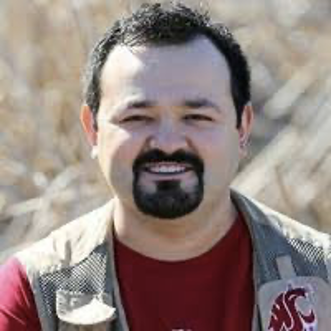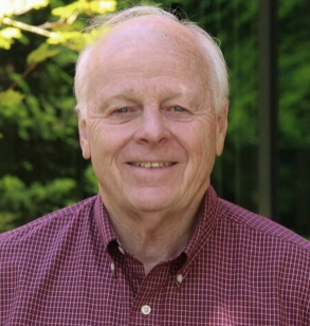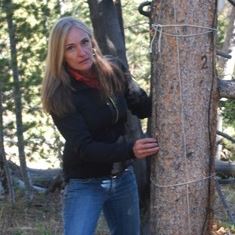|
The history of DEMO: An experiment in regeneration harvest of northwestern forest ecosystems. Northwest Science 73:3-11.
|
2024 MEETING
 Centennial Science 100 years since the Association first convened May 20-23, 2024 Gonzaga University, Spokane Monday, May 20: Evening social. College Commons, Humanities Building, Gonzaga. 5:00-8:00 pm. Includes an informal presentation by Nick Zentner on the interesting connections between the geologist J Harlen Bretz, the early investigations of the Missoula floods, and events surrounding the founding of the Northwest Scientific Association in Spokane in 1923. Tuesday and Wednesday, May 21/22:
Thursday, May 23: Field trip to the Turnbull National Wildlife Refuge (details below) |
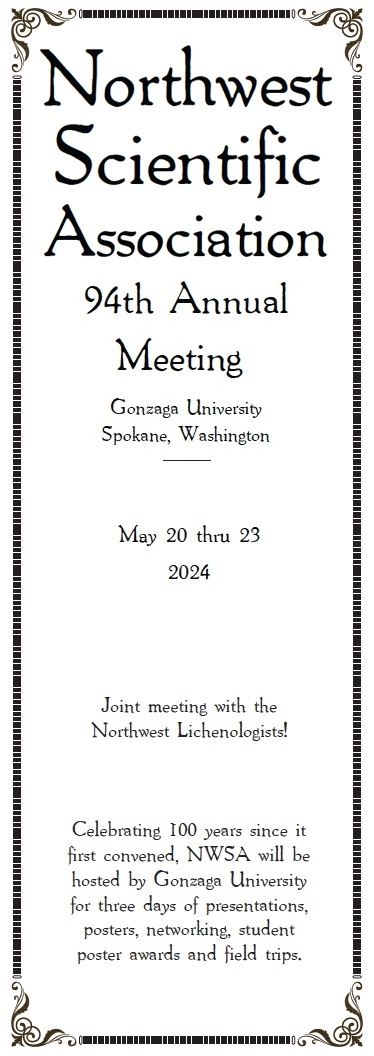
|
Plenary Speakers
|
|
|
|
|
Erim Gómez Assistant Professor of Wildlife Biology, University of Montana Age of invasive species: Inland Northwest amphibian case study |
Richard Waitt Research Geologist, USGS Cascades Volcano Observatory The “debacle which swept the Columbia Plateau” one hundred years on |
Diana Six Professor of Forest Entomology, University of Montana From microbes to ecosystems: How bark beetles do what they do |
Full Program without abstracts (PDF) (updated May 17)
Alphabetical list of contributed abstracts.
Special Sessions:
- Forest Health and Disturbance Ecology: Organized by Dave Shaw
- Pacific Northwest Geology: Organized by Brian Atwater
The Executive Committee of the nascent Northwest Scientific Association met in Spokane on 9 November 1923 after attending a public lecture, by Kirk Bryan, about "The geology of the Spokane region." In May 2024, NWSA will continue this tradition by highlighting Pacific Northwest geology in a keynote address, in a special session of contributed talks, and in posters.
- Science of Coeur d'Alene Lake: Organized by Dan Gavin
Field trip to Turnbull National Wildlife Refuge: Led by Peggy O'Connell and Suzanne Schwab, Eastern Washington University

This half-day field trip will visit the Channeled Scablands of Turnbull National Wildlife Refuge. Here, ponderosa pine woodlands and wetlands carved out by the Missoula Floods harbor a diversity of wildlife. Our trip should coincide with the peak of the spring wildflower bloom, so Turnbull’s colorful flora will be a highlight of our visit. The refuge is a favorite site for local birdwatchers, with about 200 breeding, resident, and migrating bird species including resident trumpeter swans and other waterfowl. We may even spot some of the refuge’s mammals, including badgers, porcupines, and moose. We will explore Turnbull’s landscapes and biodiversity by driving the Pine Lake Auto Loop and, weather-permitting, walking some short trails. Since its founding in 1937, the refuge has been an important site for field research. This research has ranged from geomorphology to fire recovery to forestry to wildlife management to the impacts of invasive species, so regardless of your interests, there’s something for you at Turnbull!
Abstracts and Registration
Abstract submission is now closed for the 2024 Annual Meeting.
Registration is open. Early registration rates end on May 10th. Become a member or verify/update your membership before registering to avoid higher registration rates and obtain a subscription to our journal Northwest Science.
Hotel and Logistics
- The Ruby River Hotel is a five minute walk to the Gonzaga Campus. Get a 20% room discount by reserving there using the promotion code "GU24".
- Dining (lunch) options available in the Hemmingson Center
- Parking: Spots will be made available in the College Hall parking lot. Note: Ruby River Hotel is in walking distance.

For more information, contact local host, John Orcutt (orcutt@gonzaga.edu), or NWSA President, Dan Gavin (dgavin@uoregon.edu).
Program committee: John Orcutt, Daniel Gavin, Keala Hagmann, Brian Atwater, Dave Shaw, Jon Riedel
| 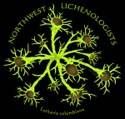 A joint meeting with the Northwest Lichenologists |
Plenary Abstracts
Erim Gomez, University of Montana, Missoula MT.
Age of Invasive Species: Inland Northwest Amphibian Case Study
The spread of invasive species is a leading driver of biodiversity loss. We will cover both global and regional examples, with a case study on regional amphibians in the Inland Northwest and the threats they face from invasive species. Amphibians are the most endangered vertebrate group worldwide, underscoring the importance of their conservation. To improve conservation and management efforts for amphibians, understanding the ecological and environmental factors that affect their habitats is crucial. We investigated amphibian occupancy across four ecoregions, from the Columbia River Basin in Central Washington to Western Montana. Our findings reveal that native amphibian populations were negatively affected by the presence of invasive fish and bullfrogs. Addressing this issue can be straightforward: increasing public awareness of the issue can prevent the spread of invasive species.
Diana Six, University of Montana, Missoula MT.
From microbes to ecosystems: How bark beetles do what they do
Many of us have seen the aftermath of tree-killing bark beetle outbreaks either in person or in the media. In response to these events, bark beetles are often portrayed as ‘destroying’ forests, but do they? Are the typically simplistic explanations offered for their behavior and effects in forests accurate? Mostly, no. Bark beetles are among the most complex organisms found in conifer forests and how they do the remarkable things they do is no less complicated. Tree-killing bark beetles are relatively rare – only about a dozen species out of thousands worldwide have this ability. So, what sets them apart? It turns out it is the interactions with little things like microfungi and big things like host tree condition and genetics. Starting from the small (microbial symbioses) and working to the big (effects on forest structure and function) I will cover how these tiny beetles manage to be the crucial ecosystem engineers that shape the structure and function of many coniferous forests around the globe. Along the way, I will do some myth-busting and discuss ways to avoid research ‘ruts’ in developing an understanding of these and other biological systems.
Richard B. Waitt, Cascades Volcano Observatory, US Geological Survey, Vancouver WA.
The “debacle which swept the Columbia Plateau” one hundred years on
“It was a debacle,” wrote J Harlan Bretz in 1923, that carved Washington’s Channeled Scabland. This prescient finale today brings to mind debacles geologic, personal, and periodic. The Oxford English Dictionary credits geology with first English use of “debacle”: “a . . . violent rush of water, which . . . carries . . . blocks of stone and other debris,” with which Playfair (1802: Huttonian Theory of the Earth) dismisses catastrophic flooding in shaping the land. Charles Lyell’s influential Principles of Geology (12 editions, 1830–1875) then eloquently all but denies catastrophic events including giant floods as plausible Earth processes. Does Bretz’s italicized “was” allude partly, ironically, to Playfair and Lyell?
The cataclysm in Bretz’s “Spokane flood” initiated a famous controversy. Published arguments against great Scabland flood erupted in the 1920s and raged on into the 1940s—critics by various Lyellian schemes calling for less water over more time. As Bretz had no published support, to many it must have seemed his personal debacle. Yet re-reading the early reports, I sense that by the extraordinary field evidence he had documented, eventually throughout the region, Bretz knew all along that catastrophysm would prevail. After Pardee showed that huge glacial Lake Missoula had discharged abruptly, Bretz and colleagues in 1956 show with the old evidence—and with stark new evidence in giant current dunes adorning many gravel bars—that water from huge glacial Lake Missoula had indeed carved the Channeled Scabland. With detailed geomorphic field evidence they skewer Bretz’s critics—this in turn their personal debacle.
Yet the story takes a more gradualistic turn with discovery that Lake Missoula drained periodically. In his final Scablands paper in 1969, Bretz by geomorphic evidence counts seven floods at most. But hardly a decade later, new stratigraphic evidence was showing that Lake Missoula released scores of giant floods during the last glaciation alone. These outbursts were both periodic and gigantic by degrees—truly colossal and coming many decades apart when the damming Purcell Trench lobe was thick, but as the ice gradually thinned diminishing to coming only a decade or a few years apart, and at the end one year apart. This scores-of jökulhlaups idea erupted new controversy, this one too lasting more than two decades. If it has simmered down lately this argument is also being settled by field evidence.
If Missoula floods were numerous and periodic during last-glacial marine isotope-stage 2 (25–15 thousand years ago), what happened during seemingly equally deep glaciations at isotope stages such as 6 and 12 (140–440 thousand years ago)? So far we know of no supporting field evidence—only scattered field sites that suggest one gigantic flood far back, perhaps a million years ago. It will be for today’s young scientists to decipher this and other remaining enigmas.
Contributed talks and posters (updated periodically)
SITKA SPRUCE ECOPHYSIOLOGY.; Lucy P. Kerhoulas, Cal Poly Humboldt, Department of Forestry, Fire, and Rangeland Management, 1 Harpst Street, Arcata, CA 95521.
FIRE ECOLOGY AND THE FORGOTTEN LICHENS; Roger Rosentreter, Department biology, 1910 University Dr., Boise State University, Boise ID 83725-1515
90 YEARS OF TREE-RING STUDIES ON SUBFOSSIL WOOD IN CASCADIA—WITH EMPHASIS ON THE PIONEERING WORK OF DONALD B. LAWRENCE AND DAVID K. YAMAGUCHI; Patrick T. Pringle, Science Department, Centralia College, Centralia, WA 98531
THE OCCURRENCE OF WESTERN OAK MISTLETOE (Phoradendron villosum subsp. villosum) ON NON-NATIVE URBAN TREES OF WESTERN OREGON, USA.; David C. Shaw, Max Bennett, Central Point, Oregon, Don Goheen, Jacksonville, Oregon, Scott Altenhoff, Oregon Department of Forestry, Salem, Oregon, Gabriela Ritokova, Oregon Department of Forestry, Salem, Oregon, Alan Kanaskie, Salem, Oregon, Stephen Calkins, Marysville, Washington.
COEUR D'ALENE LAKE: UPDATED CONCEPTUAL MODEL FOR STRUCTURE AND MIXING; D. Craig Cooper, Idaho Department of Environmental Quality, Coeur d'Alene, ID, 83814
INTERACTING DISTURBANCE ACROSS THE CLIMAX LODGEPOLE PINE FORESTS OF SOUTH-CENTRAL OREGON PUMICE PLAINS.; David Shaw, Michelle Agne, USFS PNW Research Station, Olympia, Washington.
VISUALIZING USNIC ACID IN LICHENS WITH ANISALDEHYDE REAGENT.; Bruce McCune, Department of Botany and Plant Pathology, Oregon State University, Corvallis, Oregon 97331; Wilmer H. Perera, CAMAG Scientific, Inc., 515 Cornelius Harnett Drive, Wilmington, NC 28401; Xinhui Yu, Kerry McPhail, Department of Pharmaceutical Sciences, College of Pharmacy, Oregon State University, Corvallis, Oregon 973313
MODELING RECREATIONAL RISK ON THE LANDSCAPE: A GIS ANALYSIS OF RECREATION ACCIDENT RESPONSE IN THE VICINITY OF THE I-90 CORRIDOR, WASHINGTON.; Naomi van Roon, Geography Department, Central Washington University, Ellensburg, WA 98926.
TIMING IS EVERYTHING! FOLIAR DAMAGE AND GROWTH OF DOUGLAS-FIR ASSOCIATED WITH PROVENANCE AND ENVIRONMENT.; Constance Harrington, USDA FS Pacific Northwest Research Station, Olympia, WA 98512; Richard Cronn, USDA FS Pacific Northwest Research Station, Corvallis OR 97331; Adam Sibley, Oregon State University, Corvallis, OR 97331; Kevin Ford, USDA FS Pacific Northwest Region, Portland, OR 97204; Nicholas Wilhelmi, USDA FS Flagstaff, AZ 86001; Peter Gould, Mason, Bruce & Girard, Olympia, WA 98501
FACTORS THAT COULD PREDISPOSE WESTERN REDCEDAR TO PROBLEMS IN OUR WARMING CLIMATE.; Bill Carlson Weyerhaeuser retired
AN ANNOTATED CHECKLIST OF THE BEES OF WASHINGTON STATE; Chanda S. Bartholomew, Washington State Department of Agriculture, Tumwater, WA 98501; Elizabeth Murray, Department of Entomology, Washington State University, Pullman, WA 99164; Silas Bossert, Department of Entomology, Washington State University, Pullman, WA Department of Entomology, National Museum of Natural History, Smithsonian Institution, Washington, DC 20013; Joel Gardner, Department of Entomology, Washington State University, Pullman, WA 99164; Chris Looney, Washington State Department of Agriculture, Tumwater, WA 98501
SYMBIOTIC SYNERGY: WHEN CHEMIST MEET LICHENOLOGIST; Xinhui Yu and Kerry L. McPhail. Department of Pharmaceutical Sciences, College of Pharmacy, Oregon State University, Corvallis, OR 97331, USA
METALS MATTER FOR MOSSES: POLLUTION EFFECTS ON INVERTEBRATE COMMUNITIES.; Olivia Roberts, Gabe Veltri, Kristin Hultgren, Department of Biology, Seattle University, 901 12th Ave, Seattle, WA 98122
SETTLING IN: OBSERVATIONS OF THE NESTING AND OVERWINTERING BIOLOGY OF B. impatiens IN ITS INTRODUCED RANGE.; Chris Looney, Chanda S. Bartholomew, Washington State Department of Agriculture, Tumwater WA, 98501; Jonathan B. U. Koch, Tien T. Lindsay, United States Department of Agriculture, Agricultural Research Service, Pollinating Insect-Biology, Management, Systematics Research Unit, Logan, Utah, 84341; Susan M Waters, Quamash EcoResearch, Olympia, Washington, 98504
A HYPOTHESIZED AGGREGATIVE PREDATORY RESPONSE OF WALLEYE (Sander virtues) ON WHITE STURGEON (Acipenser transmontanus) IN THE UPPER COLUMBIA RIVER IN LAKE ROOSEVELT, WASHINGTON; Seth A. Barr, Department of Biology, Eastern Washington University, 526 5th St, Cheney, WA 99004; Andy Miller, Spokane Tribal Fisheries, 1100 S Garfield Rd Suite A., Airway Heights, WA 99001; Dr. Paul Spruell, Department of Biology, Eastern Washington University, 526 5th St, Cheney, WA 99004
THE EFFECTS OF SALINITY ON THE CUTANEOUS MICROBIOME AND BD INFECTION OF THE PACIFIC TREE FROG (Pseudacris regilla).; Hannah E. Kim, Jenifer B. Walke, Department of Biology, Eastern Washington University, 526 5th St, Cheney, WA 99004
QUANTIFYING LANDSCAPE-SCALE CULTURAL BURNING PATTERNS ON KARUK ANCESTRAL TERRITORY IN NORTHERN CALIFORNIA THROUGH BLENDED INDIGENOUS AND WESTERN SCIENTIFIC METHODS. ; Skye M. Greenler, USDA Forest Service, Region 6 Ecology Program, 1220 SW 3rd Ave, Portland, OR 97204, Oregon State University, College of Forestry; Frank K. Lake, USDA Forest Service, Pacific Southwest Research Station, 1700 Bayview St, Arcata, CA 95521; Chris J. Dunn, Oregon State University, College of Forestry; Susan J. Prichard, University of Washington, School of Environmental and Forest Sciences 3715 W Stevens Wy NE, Seattle, WA 98195; Paul F. Hessburg, USDA Forest Service, Pacific Northwest Research Station 1133 N Western Ave, Wenatchee, WA 98801; John D. Bailey, Oregon State University, College of Forestry, 3100 SW Jefferson Way, Corvallis, OR 97331; William A. Tripp, Karuk Tribe Department of Natural Resources, PO Box 282, Orleans, CA 95556; Will Harling, Mid Klamath Watershed Council, 38150 CA-96, Orleans, CA 95556
RARE PLANTS AND POLLINATOR DIVERSITY IN THE PACIFIC NORTHWEST.; Susan M. Waters, David Cappaert, Quamash EcoResearch, 2023 46th Ave NE Olympia, WA 98506; Scott Harris, Thomas Kaye, Christina Mitchell, Institute of Applied Ecology, 4950 SW Hout St., Corvallis, OR 97333
DIFFERENTIAL WATER HOLDING CAPACITY IN BRYOPHYTE SPECIES AND ORGANIZATIONAL LEVELS.; Meghan Lake, Jessica Allen, Krisztian Magori, Department of Biology Eastern Washington University, Cheney, WA 99004; Bruce McCune, Posy Busby, Sofia Green, Mark Schulze, Department of Botany and Plant Pathology, Oregon State University, Corvallis, OR 97331; Joseph LaManna, Department of Biological Sciences, Marquette University, WI 53233; Jeffery Diez, Department of Biology, University of Oregon, Eugene, OR 97403
THE EFFECT OF MOON PHASE ON PREDATOR AND PREY ACTIVITY LEVELS ON TURNBULL NATIONAL WILDLIFE REFUGE.; Jeff Schell, Charlotte Milling, Department of Biology, Eastern Washington University, 1175 Washington Street, Cheney, WA, 99004
STRATEGIES TO TOLERATE TRACE METAL MIXTURES EMPLOYED BY MACROINVERTEBRATES IN THE LATERAL LAKES OF THE COEUR D’ALENE RIVER.; Chantilly Higbee; Dechen Edwards; Roxanne McPeck; Aleesha Grove, Department of Biology, Eastern Washington University, Cheney, WA 99004; Helen Poynton, School for the Environment, University of Massachusetts, Boston, Boston, MA 02125; Jenifer Walke, Department of Biology, Eastern Washington University, Cheney, WA 99004; Carmen Nezat, Department of Geosciences, Eastern Washington University, Cheney, WA 99004; Joanna Joyner-Matos, Department of Biology, Eastern Washington University, Cheney, WA 99004
AN INDEX OF BIOTIC INTEGRITY FOR MACROINVERTEBRATE STREAM BIOASSESSMENT CONDUCTED BY COMMUNITY SCIENTISTS IN THE PACIFIC NORTHWEST.; Elisa Mickelson, Patrick M. Edwards, Environmental Science and Management, Portland State University, Box 751, Portland, OR 97207-0751
CLIMATE HISTORY SINCE THE MISSOULA FLOODS RECORDED IN THE SEDIMENTS OF THE PROGRADING DELTA OF THE ST JOE RIVER, COEUR D'ALENE LAKE. Daniel Gavin, Department of Geography, University of Oregon.
A RIVER IN TIME: THE GEOLOGIC HISTORY OF SKAGIT RIVER VALLEY, WASHINGTON.; Jon L. Riedel, Western Washington University, Bellingham, WA 98229
COMPARISON OF BIODIVERISTY IN TEMPORARY AND PERMANENT PONDS.; Rosie Ogborn, Gonzaga University, Spokane, WA 99258; Courtney Hendrickson, Oregon State University, Corvallis, OR 97331; Carson Sellers, Mia Mastrangelo, Holly Fijolek, Joseph Baum, Owen Vanderpuy, Bella Centanaro-Castro, Lily Sager, Mia Lucas, Clare McGowan, Katie Ellis, Allie Greenhouse, Sidney Ashby, Betsy Bancroft, Gonzaga University, Spokane, WA 99258
THE EVERGREEN STATE COLLEGE PARKING LOTS: A HOTSPOT FOR MACROLICHEN DIVERSITY. ;Elise Grage, Lalita Calabria, The Evergreen State College, 2700 Evergreen Parkway NW, Olympia, WA 98505
SPECIES ABUNDANCE AND RICHNESS OF NATIVE BEES IN EWU'S PRARIE RESTORATION SITE COMPARED TO ADJACENT WHEAT FIELD, AND NATURAL AREAS.;Alejandro Torres-Gonzalez, Justin Bastow, Biology Department, Eastern Washington University, 1175 Washington St., SCI 226, Cheney, WA 99004
INDICATORS OF BIODIVERSITY ACROSS TAXA FOR EARLY SERAL FORESTS;Graham Frank, Department of Forest Ecosystems and Society, Oregon State University, Corvallis, OR 97331; Jake Verschuyl, National Council for Air & Stream Improvement, Anacortes, WA 98221; Matt Betts, Department of Forest Ecosystems and Society, Oregon State University, Corvallis, OR 97331; James W. Rivers, Mark Swanson, Department of Forest Engineering, Resources & Management, Oregon State University, Corvallis, OR 97331; Meg Krawchuk, Department of Forest Ecosystems and Society, Oregon State University, Corvallis, OR 97331
EXAMINING THE DRIVERS OF NOCTURNAL BEHAVIOR OF PIKAS AT LOWER ELEVATIONS IN LASSEN NATIONAL FOREST, CALIFORNIA.;Evan Burnett, Rick Brown, Department of Wildlife, Cal Poly Humboldt, 1st Harpst St, Arcata, CA, 95521; Tom Rickman, Lassen National Forest, United States Forest Service, 477-050 Eagle Lake Road, Susanville, CA 96130
SUCCESSIONAL TRAJECTORIES IN POST-FIRE FORESTS: INSIGHTS FROM REVISITED FOREST INVENTORY PLOTS IN THE PACIFIC NORTHWEST.;Claire Tortorelli; Matthew Reilly, USDA Forest Service, Pacific Northwest Research Station, Corvallis, OR, 97330; Derek J. Young; Andrew M. Latimer, University of California, Davis, 1 Shields Ave, Davis, CA 95616
CONSERVATION GRAZING: PUBLIC- PRIVATE PARTNERSHIPS FOR GRASSLAND RESTORATION TO PROMOTE POLLINATOR DIVERSITY.;Cody B. Blackketter, Marisa D. Fisher, Susan M. Waters, 2302 46th Ave NE, Olympia, WA 98506
POLLINATORS OF TWO RARE WASHINGTON SHRUB-STEPPE ENDEMIC PLANTS.;Cody B. Blackketter, Marisa D. Fisher, Erin M. Mau, Susan M. Waters, Quamash EcoResearch, 2302 46th Ave NE, Olympia, WA 98506
EFFECTS OF TIME, LOCATION, AND HIVE WEIGHT ON HONEY BEE (Apis mellifera) GUT MICROBIOME COMPOSITION AND DIVERSITY;Jonah O. Frago, Jenifer Walke, Department of Biology, Eastern Washington University, 526 5th st, Cheney, WA 99004
FLORAL MUTUALISTS AND ANTAGONISTS OF AN ENDANGERED MONTANE WILDFLOWER IN EASTERN WASHINGTON.;Marisa D. Fisher, Cody B. Blackketter, Erin M. Mau, Susan M. Waters, Quamash EcoResearch, 2302 46th Ave NE, Olympia, WA 98506
CHANGES IN AQUATIC INSECT FAUNA ALONG MILL CREEK (BLUE MOUNTAINS, SE WA) AND CAUSATIVE FACTORS;Quinn E. Miller; Heidi E.M. Dobson; Lucien Rochelois; Briley Shults, Department of Biology, Whitman College, Walla Walla, WA 99362
ESTIMATED DISPERSAL ABILITIES OF A DIVERSE WILD BEE ASSEMBLAGE ACROSS A FRAGMENTED ENDANGERED ECOSYSTEM.;Justin Bastow, Emma Hoskins, Eastern Washington University, Biology Department, 1175 Washington St. SCI 226, Cheney, WA 99004
RARITY, CAUSE OR CONSEQUENCE: COMPARATIVE POPULATION GENOMICS OF SIX LICHENIZED FUNGI WITH CONTRASTING RANGE SIZES, LIFE HISTORIES, AND MORPHOLOGIES;Stephen T. Sharrett, Department of Biology, Eastern Washington University, Cheney, WA 99004.; Julianna Paulsen, Department of Biology, Eastern Washington University, Cheney, WA 99004.; James C. Lendemer, Department of Botany, Research & Collections, The New York State Museum, Albany, NY 12230; Krisztian Magori, Department of Biology, Eastern Washington University, Cheney, WA 99004; Jesse E.D. Miller, Natural Heritage Program, Washington State Department of Natural Resources, Olympia, WA 98501; Jessica L. Allen, Department of Biology, Eastern Washington University, Cheney, WA 99004
VOLCANIC ASH IN A VARVED RECORD OF MISSOULA-FLOOD PERIODICITY.; Brian F. Atwater, U.S. Geological Survey at University of Washington, Seattle, WA 98195-1310; Michelle A. Hanson, Saskatchewan Geological Survey, 1945 Hamilton Street, Regina, SK S4P 2C7; Richard B. Waitt, U.S. Geological Survey, Cascades Volcano Observatory, 1300 SE Cardinal Court, Suite 100, Vancouver, WA 98693; Jim E. O’Connor, U.S. Geological Survey, 2130 SW 5th Ave., Portland, OR 97201; Laura C. Walkup, Geology, Minerals, Energy, and Geophysics Science Center, U.S. Geological Survey, 345 Middlefield Road MS 975, Menlo Park, CA 94025
PALEOENVIRONMENT AND LOCOMOTION OF THE DESMOSTYLIAN Behemotops proteus; John D. Orcutt, Ella K. Stewart, Brynn I. Leonard, Kevin C. Talbott, Michael J. Monroe, Department of Biology, Gonzaga University, Spokane, WA 99258
EARTHQUAKE EFFECTS SURVEYED DURING THE NINETEENTH CENTURY AS ECOLOGICAL FEATURES OF CHINOOKAN TIDELANDS.; Brian F. Atwater, U.S. Geological Survey at University of Washington, Seattle, WA 98195-1310; David K. Yamaguchi, Japan-America Society of the State of Washington, 3010 77th Ave. SE, Suite 102, Mercer Island, WA 98040; Jessie K. Pearl, The Nature Conservancy, 1510 East Fort Lowell Road, Tucson, AZ 85719
FACILITATING TRANSFORMATION TO MULTI-AGED STRUCTURES IN NORTHERN ROCKY MOUNTAIN PONDEORSA PINE (Pinus ponderosa) FORESTS.; Neil G. Williams; Justin S. Crotteau, U.S. Department of Agriculture, Forest Service, Rocky Mountain Research Station, Forestry Science Laboratory, 800 E Beckwith Ave, Missoula, MT 59801; Sharon M. Hood, USDA Forest Service, Rocky Mountain Research Station, 5775 W Broadway St, Missoula, MT 59808; Cheri L. Hartless, USDA Forest Service, Washington Office, Sidney R. Yates Federal Building, 201 14th St SW, Washington, DC 20227; Shelagh R. Fox, USDA Forest Service, Northern Region, 26 Fort Missoula Rd, Missoula, MT 59804.
THE FRENCHMAN HILLS – TONNEMAKER MAMMOTH SITE, GRANT COUNTY, WASHINGTON; George V. Last, 1938 Harris Ave., Richland, WA; Mark S. Amara, 4875 Bluff Dr NE, Moses Lake, WA 98837; Kole A. Tonnemaker, Luke E. Tonnemaker, Tonnemaker Hill Farm, 9098 Dodson Rd S, Royal City, WA 99357; Bax R. Barton, R. L. Faubion, Gary C. Kleinknecht, Neil L. Mara, Mid-Columbia Basin Old Natural Education Sciences Research Center Foundation, 33585 S. Clodfeter Rd., Kennewick, WA 99338; Tammy M. Rittenour, Utah State University, 4505 Old Main Hill, Logan, UT 84322
SPECIES ABUNDANCE AND RICHNESS OF NATIVE BEES IN EWU'S PRARIE RESTORATION SITE COMPARED TO ADJACENT WHEAT FIELD, AND NATURAL AREAS.; Alejandro Torres-Gonzalez, Justin Bastow, Biology Department, Eastern Washington University, 1175 Washington St., SCI 226, Cheney, WA 99004
RIPARIAN FOREST TREATMENT ALONG EAST FORK BIG CREEK, MALHEUR NATIONAL FOREST.; Amarina Wuenschel, Region 6 Ecology Program, U.S. Forest Service, 1550 Dewey Avenue, Suite A, Baker City OR 97814; Upekala Wijayratne, Region 6 Ecology Program, U.S. Forest Service, 16500 Champion Way, Sandy OR 97055; Caroline Beshears, Deschutes National Forest, U.S. Forest Service, 63095 Deschutes Market Road, Bend OR 97701
I GOT NINETY-NINE PROBLEMS BUT FINDING Hypotrachyna afrorevoluta AIN'T ONE: AN UPDATE ON THE DISTRIBUTION OF A RARE, UNDER-RECORDED LICHEN IN WASHINGTON STATE.; Lalita M. Calabria; Nicholas Reinhart, Environmental Studies, The Evergreen State College, 2700 Evergreen Pkwy NW, Olympia, WA 98505
DECONSTRUCTING WHITE IMPERIALIST PARADIGMS IN SCIENCE: INTEGRATING INTERDISCIPLINARY FRAMEWORKS INTO BIOLOGICAL RESEARCH.; Meg Lake, Stephen Sharrett, Elaine Larsen, Julianna Paulsen, Jessica Allen, Department of Biology, Eastern Washington University, Cheney, WA 99004
POST-FIRE RECOVERY OF MIXED-CONIFER FORESTS IN THE BLUE MOUNTAINS: RELATIONSHIPS BETWEEN SPECTRAL RECOVERY AND FIELD DATA; Joe V. Celebrezze, Madeline C. Franz, Robert A. Andrus, Amanda T. Stahl, Arjan J. H. Meddens, School of the Environment, Washington State University, PO Box 642812, Pullman, WA 99614; Michelle Steen-Adams, School of the Environment, Washington State University, Vancouver, WA 98686
MOBILE GENETIC ELEMENTS IN RARE, THREATENED, AND RANGE-RESTRICTED LICHENIZED FUNGI.; Julianna Paulsen, Stephen Sharrett, Devin Mumey, Eastern Washington University, Cheney, WA James Lendemer, Lalita M. Calabria, Jordan Hoffman, Eli Balderas, and Jessica L. Allen
EXPANSION OF THE EXOTIC BUMBLE BEE Bombus impatiens (CRESSON) IN BRITISH COLUMBIA AND WASHINGTON STATE; Chris Looney, Chanda Bartholomew, Washington State Department of Agriculture, Tumwater WA, 98501; Jonathan B. U. Koch, United States Department of Agriculture, Agricultural Research Service, Pollinating Insect-Biology, Management, Systematics Research Unit, Logan, Utah, 84341; Susan M Waters, Quamash EcoResearch, Olympia, Washington, 98504; Sandra Gillespie, University of the Fraser Valley, Abbotsford, BC, V2S7M8; Julie K. Combs, Washington Department of Fish and Wildlife, Olympia, WA, 98501.
MODELING THE EFFECTS OF CLIMATE CHANGE ON HABITAT SUITABILITY FOR Ludwigia spp. AND Fallopia spp. IN THE PACIFIC NORTHWEST.; Emily E. Smoot, School of Marine and Environmental Affairs, University of Washington, 3707 Brooklyn Ave NE, Seattle, WA, 98105; Rebecca L. Filtcroft, US Department of Agriculture, Forest Service, Pacific Northwest Research Station, 3200 SW Jefferson Way, Corvallis, OR, USA, 97331; Braeden Van Deynze, Washington Department of Fish and Wildlife, 1111 Washington St SE, Olympia, WA, 98501; Sean Ewen, Sunny L. Jardine, School of Marine and Environmental Affairs, University of Washington, 3707 Brooklyn Ave NE, Seattle, WA, 98105; Gwendolynn W. Bury, Oregon State University, 1500 SW Jefferson Way, Corvallis, OR, 97331
WILDFIRE IMPACTS ON LARGE TREES: DIVERGING FIRE EFFECTS AND MANAGEMENT IMPLICATIONS IN OPEN VS. CLOSED CANOPY FORESTS; Garrett Meigs, Derek Churchill, Dan Donato, Josh Halofsky, Annie Smith, Washington State Department of Natural Resources, 1111 Washington Street SE, Olympia, WA 98504; Caden Chamberlain, Gina Cova, Jonathan Kane, Van Kane, Susan Prichard, School of Environmental and Forest Sciences, University of Washington, 3715 W Stevens Way NE, Seattle, WA 98195; Alina Cansler, Franke College of Forestry and Conservation, University of Montana, 32 Campus Drive, Missoula, MT 59812; James Begley, Washington Conservation Science Institute, P.O. Box 484, Roslyn, WA 98941
LOW-COST IOT PLATFORMS FOR POPULATION HEALTH METRIC COLLECTION BY CITIZEN SCIENTISTS; Srihari Yamanoor, Narasimha Sai Yamanoor, DesignAbly, Vallejo, CA 94590
Nostoc GENOME ANNOUNCEMENT.; Elaine M. Larsen, Carissa Morrison, Department of Biology, Eastern Washington University, 526 5th St, Cheney, WA 99004
UNDERGRADUATE RESEARCH IDENTIFYING FOCAL PLANTS IN THE RESTORATION OF FLOWER-INSECT COMMUNITIES; Heidi E M Dobson, Lauren O'Rourke, Department of Biology, Whitman College, Walla Walla, WA 99362; Fraser Moore, Blue Mountain Land Trust, PO Box 1473, Walla Walla, WA, 99362
DETERMINING THE LONG-TERM EFFECTIVENESS OF SEEDING POST-DAM REMOVAL IN THE ELWHA RIVER, WA, THROUGH SOIL SEED BANK ANALYSIS.; Makenna Tabino, Department of Biology, Eastern Washington University 526 5th St, Cheney, WA 99004; Rebecca Brown, Department of Biology, Eastern Washington University 526 5th St, Cheney, WA 99004
 NORTHWEST SCIENTIFIC ASSOCIATION
NORTHWEST SCIENTIFIC ASSOCIATION